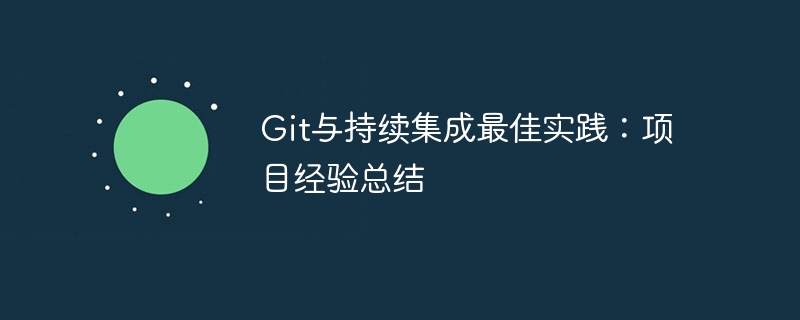
In today's software development world, Git and continuous integration have become an indispensable part. Git is a distributed version control system that can greatly simplify multi-person collaboration and ensure the version history and security of the code. Continuous integration is an automated process that continuously integrates code into the main branch. It can automatically run test cases and build processes to ensure that each modification is stable and available. This article combines personal project experience to summarize the best practices of Git and continuous integration.
1. Git best practices
- Branch management
In multi-person collaboration, using correct branch management can help reduce the risk of conflicts and errors. It is recommended to use the following method for branch management:
- Master branch (master): used to release official versions, only related to stable versions.
- Development branch (develop): used for main development, including all new features and modifications.
- Feature branches: Each new feature and modification is developed on its own branch and merged into the develop branch after development is completed.
- Patch branches (hotfix branches): Used to urgently fix errors on the main branch.
- Submission specifications
Submitting code in a standardized manner is a good habit and will also help greatly simplify code review and maintenance. It is recommended to use the following format for submission comments:
feat: New features
fix: Bug fixes
docs: Documentation changes
style: Code style modifications
refactor: Refactoring
test: Test Code
chore: Build or tool changes
- Regular merge requests
Whether in single development or multi-person collaboration, regular merge requests are a very important step, which allows everyone to You can keep abreast of the project progress at any time to avoid project problems caused by errors during merging. It is recommended to merge at least once a day. In addition, observe the merge requests messages and comments of each branch, promptly solve the problems and suggestions raised by other developers, and improve the code quality.
2. Best practices for continuous integration
- Automated testing
Automated testing is the core link of continuous integration, which can effectively reduce the risk of code errors and failed Builds . Including unit testing, integration testing, end-to-end testing and other testing methods. It is recommended to set up automatic test execution on the CI/CD platform, regularly capture and report errors or failed tests, and conduct error troubleshooting and repair for test failures.
- Building and Deployment
Building and deployment are also very important. You should ensure that this part of the script is automated and reusable, and set different configuration items for different development and production environments to facilitate rapid deployment and online deployment. It is recommended to use container technology, such as Docker, to quickly create, deploy, and maintain images.
- Quality Check
Continuous integration can integrate quality inspection into the automated process. Various code review tools, code formatting tools, code security scans, etc. can be configured according to project needs. These tools can be run before a build, improving code quality and reliability by standardizing the development process.
3. Precautions
- Security
When setting up Git and CI/CD environments, be sure to ensure the security of the system and code. This includes preventing access by malicious users, preventing data leaks and intrusions, and protecting sensitive information.
- Monitoring logs
Continuous integration requires monitoring logs to detect problems and errors in a timely manner. For example, the reasons for build failure and test failure should be investigated urgently to find out and solve the problem. Continuously iterate and optimize processes to improve efficiency.
- Team collaboration
Finally, continuous integration must be used as a collaboration tool for the entire development team. It not only needs to assume the role of technical architecture, but also needs to promote team collaboration. Developers need to have a deep understanding of each other's work content and plans, collaborate on tools, and improve overall work efficiency.
Conclusion:
This article introduces the best practices of Git and continuous integration. These practical methods have been proven to be very effective for project development and team collaboration, and can help the team avoid many problems. Frequently asked questions. At the same time, continuous adjustment and optimization are required when applying these practices to better adapt to project needs and team characteristics.
The above is the detailed content of Git and continuous integration best practices: summary of project experience. For more information, please follow other related articles on the PHP Chinese website!






